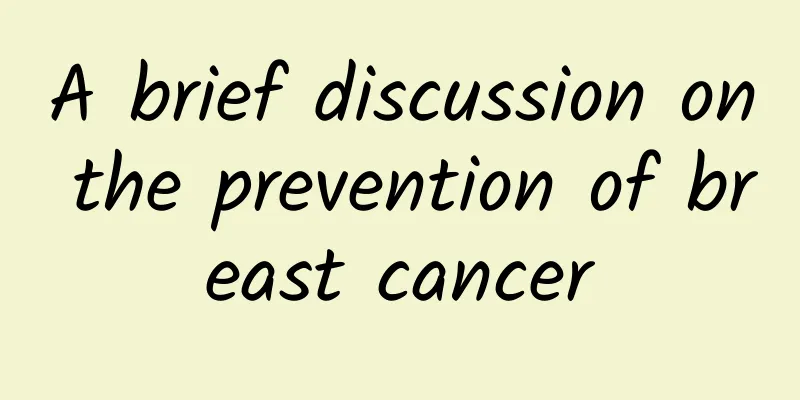A brief discussion on the prevention of breast cancer

|
Breast cancer is a common cancer among women and the fifth leading cause of cancer death worldwide. Its incidence rate in my country is increasing year by year, seriously endangering women's health and becoming the number one "beauty killer". The questions that women may be concerned about are: Why do we get breast cancer? How can we stay away from the harm of breast cancer? What can we do? Although the cause of breast cancer is not yet fully understood, research has found that there are some regularities in the onset of breast cancer. The risk factors for breast cancer are divided into two categories: breast cancer risk factors that cannot be changed by individuals (such as gender, age, ethnicity, race, environment, family history of breast cancer, etc.) and breast cancer risk factors related to lifestyle. This article focuses on lifestyle-related breast cancer risk factors and prevention methods. What are the lifestyle-related risk factors for breast cancer? 1. Drinking and smoking: Drinking increases the risk of breast cancer in women. The higher the amount of alcohol consumed, the higher the risk. Women who drink every day have a 7%-9% higher risk of breast cancer than women who do not drink. Smoking also increases the risk of cancer, including passive smoking. 2. Overweight or obesity: Overweight or obesity after menopause increases the risk of cancer in women. For every 5kg/㎡ increase in weight in adult women, the risk of breast cancer increases by 18%. 3. Diabetes: Studies have shown that diabetes is a risk factor for breast cancer, and breast cancer patients with diabetes have a worse prognosis. 4. Lack of physical exercise: For example, a sedentary lifestyle increases the risk of breast cancer. 5. No childbearing, no breastfeeding: Women who have never been pregnant or have their first child after the age of 30 have about twice the risk of breast cancer as women who gave birth before the age of 30. Women who choose to breastfeed can reduce their risk of breast cancer 6. Use of estrogen-containing drugs: such as oral contraceptives, can slightly increase the risk of breast cancer. Based on the above risk factors for breast cancer, what can we do to reduce the risk of breast cancer? 1. Do not drink, do not smoke, and stay away from secondhand smoke. 2. Control your weight, and keep your BMI between 18.5-24kg/㎡ (We usually use the body mass index (BMI) as a simple indicator to judge obesity. BMI (kg/m2) = weight/height. BMI ≥ 28.0kg/㎡ is obese, 24.0-<28.0kg/㎡ is overweight, 18.5-<24.0kg/㎡ is normal weight, and <18.5kg/㎡ is underweight.) 3. Appropriate physical exercise: Regular exercise can not only prevent obesity, lower sex hormone levels, and lower blood insulin levels, all of which help reduce the risk of breast cancer. 4. For diabetic patients, actively seek treatment and take timely dietary and lifestyle interventions to control blood sugar. 5. Relieve stress in life, control negative emotions, and maintain good sleep. Mental stress, anxiety, depression, etc. can lead to endocrine disorders and increase the risk of disease. 6. Have children at the appropriate age and insist on breastfeeding. 7. Dietary nutritional factors may also be important factors affecting the occurrence of breast cancer, but there are few studies on dietary habits and breast cancer in Asia. Current research on Chinese people has found that soy intake may be a protective factor for breast cancer. High intake of soy products during adolescence may reduce the risk of breast cancer in adulthood. Therefore, soy products such as tofu and soy milk can be added to your daily diet. The Breast Cancer Diagnosis and Treatment Guidelines (2018 Edition) published in Japan states that consuming dairy products may reduce the risk of breast cancer. Therefore, in order to prevent breast cancer, it is recommended to drink at least 240ml of low-fat milk every day. As long as women do not smoke, do not drink, maintain good eating and exercise habits, and maintain a good mood, they can significantly reduce the risk of breast cancer. If we stay away from these risk factors, will we not get breast cancer? The answer is no. Currently, there is no method that can completely prevent breast cancer. Since we cannot achieve accurate etiological prevention, we can focus on pathological prevention, early detection, early diagnosis, and early treatment to improve survival rates and reduce mortality rates. Early detection is the core and key of the three early measures. Through effective, simple, and economical breast examinations, we can achieve the goals of early detection, early diagnosis, and early treatment. What are the specific screening methods? 1. Self-examination: Adhere to regular breast self-examination, including observing the breasts, experiencing changes in subjective symptoms, and mastering the method of breast self-examination 2. Clinical Breast Examination: Breast Palpation by the Surgeon 3. Mammography: It is recommended to have a mammography examination every 1-2 years 4. Breast ultrasound examination: simple and convenient, no radiation, can be used as a routine breast cancer screening method 5. Breast Magnetic Resonance Imaging (MRI): If mammography and ultrasound examinations show suspected breast cancer, MRI examination can be further performed. Compared with other malignant tumors, breast cancer has a relatively high survival rate. The five-year survival rate of early breast cancer, such as breast carcinoma in situ, is 99% to 100%, and the five-year survival rate of stage I breast cancer in Shanghai has reached 93%. Therefore, early detection, early diagnosis, early treatment, and standardized treatment are particularly important in the prevention and treatment of breast cancer. The breast is an important organ for us women and needs our careful care. Learn the common sense of breast health care, prevent problems from happening, avoid being afraid of seeing a doctor, and protect and save breasts, starting from each person. Author: Cai Kangxin Shanghai Fengxian District Traditional Chinese Medicine Hospital |
<<: Battle against tooth decay! -- Scientific tooth care protects your child's bright smile
>>: Scientific rumor-busting | How many of the top 10 myths about oral health do you believe?
Recommend
What food is good to eat after the menstrual period ends?
It takes some time for a woman's body to reco...
What is the reason for heavy blood stasis during menstruation
Because the periodic shedding of the female endom...
Kenshoo: UK shoppers are mobile internet users, but still prefer to shop on PC
Research shows that UK internet users are no slow...
If someone around you suddenly feels dizzy and nauseous, how should you provide first aid?
Author: Tang Qin, Deputy Secretary-General of the...
7 ways to prevent breast sagging
Breast sagging can make a woman's figure a li...
What is the difference between king crab and crab? Benefits of eating king crab
Cooking can be a simple matter, just pour the foo...
Why should women eat less eels?
Loach also contains a lot of vitamin D, which is ...
After the advent of voluntary blood donation, some people felt dizzy. What is the reason?
Author: Ye Huifen Author unit: Dongguan Central B...
Can pregnant women eat foie gras?
For women, pregnancy is a very happy thing, becau...
What can I eat to get rid of pregnancy spots?
Generally, there are many foods that can remove p...
What is the best treatment for chronic pelvic inflammatory disease?
The most common female disease is inflammatory di...
How long does it take to give birth?
The ten months of pregnancy that we often talk ab...
Talking about health literacy | No disease ≠ health, understand this and you can easily get the health bonus
Health literacy is an important indicator for mea...
Causes of right groin pain in women
I believe everyone knows the importance of the gr...
Pictures of women wearing tights
Girls love tight pants just as much as long skirt...









